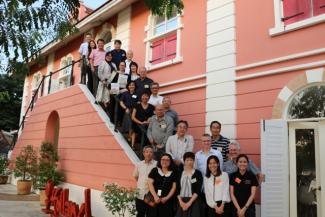
This year, Dutch maritime archaeologists have been exchanging know-how with their Japanese counterparts, for instance in the excavation of the wreck of a 19th century Dutch ship near the Okinawa coast. In March, Cees van ’t Veen, director of the Cultural Heritage Agency of the Netherlands (RCE), visited Japan at the invitation of the Kyushu National Museum as part of their knowledge exchange in the field of maritime archaeology. Mr. van ’t Veen also launched an exhibition on ‘adaptive reuse’, a strategy to revitalise historical inner cities, which is also a hot topic in Japan. This paid off immediately, as the Japan-Netherlands Architectural Cultural Association (JNACA) invited the Dutch architectural office space & matter to do a workshop on this topic with students of Saga University, using an old townhouse in the historical city of Arita. Saga University, RCE and JNACA are currently exploring the possibility of holding a larger workshop involving more cities.
The Dutch East India Company’s two former trading posts in Japan, the Hirado Dutch Trading Post and the Nagasaki Deshima Trading Post, are both increasingly active in international cultural networks. Hirado is the headquarters for the Dutch Trading Post Heritage Network, which was established to connect former Dutch trading posts in the East Asian region. In November of this year, the third annual meeting of the Network was held in Ayutthaya, Thailand, with representatives from organisations in Japan, Indonesia, Taiwan, Malaysia, Thailand, Sri Lanka and the Netherlands attending. The programme included a workshop on storytelling held by Theo Meereboer, a specialist in museum concepts from the RCE, seeing as the affiliated organisations are working on a joint exhibition to introduce the Network to a wide audience. In 2017, the fourth annual meeting will be held in Nagasaki, Japan. Here, at the former Dutch trading post on Deshima, six reconstructed buildings from the beginning of the 17th century have just been opened. They feature a presentation showing how Deshima and the Dutch connected Japan to the world: goods coming from all over Asia and Europe were unloaded from the ships at Deshima’s ‘sui-mon’ (water-gate), and hauled across the narrow Omotemonbashi bridge into Japan. The reconstruction of this narrow bridge is scheduled for completion in November 2017 and will be the last part of the Holland-Kyushu 2016-2017 project. This collaboration between DutchCulture, the Netherlands Embassy and the local partners in Kyushu has become a huge success in its first year, creating many new exchanges, activating new networks and generating a lot of press attention*.
* The Dutch radio programme Onvoltooid Verleden Tijd broadcasts a documentary on the Deshima project in two parts. The Japanese national television also did a special on the project in a popular TV programme.


